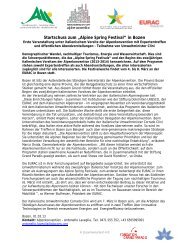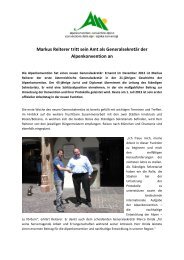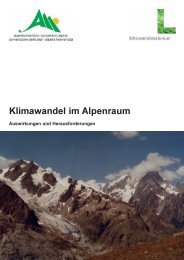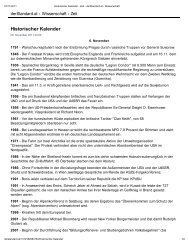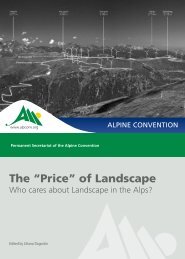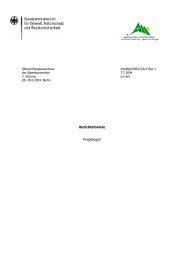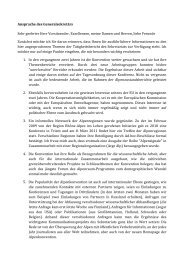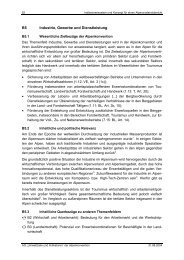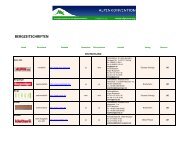Multifunctional close-to-nature forest management and wildlife ...
Multifunctional close-to-nature forest management and wildlife ...
Multifunctional close-to-nature forest management and wildlife ...
You also want an ePaper? Increase the reach of your titles
YUMPU automatically turns print PDFs into web optimized ePapers that Google loves.
<strong>Multifunctional</strong><br />
<strong>close</strong>-<strong>to</strong>-<strong>nature</strong> <strong>forest</strong><br />
<strong>management</strong> <strong>and</strong> <strong>wildlife</strong><br />
<strong>management</strong><br />
Jean-Philippe Schütz<br />
honorary prof. of silviculture at ETH Zürich<br />
President ProSilva Europe<br />
Large carnivores <strong>and</strong> wild ungulate; Innsbruck Febr. 2nd 2010 1
Background<br />
• Think movement <strong>close</strong>-<strong>to</strong>-<strong>nature</strong><br />
silviculture an universitary level<br />
- perialpine axis Ljubljana : Vienna<br />
Munich : ETH Zürich<br />
• Pro Silva Europe, NGO for<br />
practitioners with convictions for<br />
<strong>close</strong>-<strong>to</strong>-<strong>nature</strong> <strong>forest</strong> application<br />
- 25 national associations<br />
Large carnivores <strong>and</strong> wild ungulate; Innsbruck Febr. 2nd 2010 2
Pro Silva principles<br />
Pro Silva promotes <strong>forest</strong> <strong>management</strong><br />
strategies which optimize the<br />
maintenance, conservation <strong>and</strong> utilisation<br />
of <strong>forest</strong> ecosystems in such a way that<br />
the ecological <strong>and</strong> socio-economic<br />
functions are sustainable <strong>and</strong> profitable<br />
The general approach <strong>to</strong> <strong>management</strong><br />
includes market <strong>and</strong> non-market<br />
objectives <strong>and</strong> takes the whole <strong>forest</strong><br />
ecosystem in<strong>to</strong> consideration<br />
Large carnivores <strong>and</strong> wild ungulate; Innsbruck Febr. 2nd 2010 3
Duality of <strong>forest</strong> <strong>management</strong> systems<br />
Monoculture<br />
Agro like timber<br />
fac<strong>to</strong>ry<br />
ProSilva conception<br />
ecosystemic multiple use of<br />
the <strong>forest</strong>s<br />
Large carnivores <strong>and</strong> wild ungulate; Innsbruck Febr. 2nd 2010 4
Principles<br />
• Not monetary return is determinant but<br />
a sound balance between economic,<br />
social <strong>and</strong> ecological values<br />
• Use of selfregulation processes inspired<br />
by natural <strong>forest</strong><br />
• Economic efficiency based on<br />
biorationalisation <strong>and</strong> high timber value<br />
• Stem by stem operating (large timber)<br />
• Continous renewal, mostly natural<br />
• Risks diversification<br />
• Adaptivity<br />
Large carnivores <strong>and</strong> wild ungulate; Innsbruck Febr. 2nd 2010 5
Well proven systems<br />
• Plenter <strong>forest</strong> (selection system)<br />
• Mixtures<br />
• Mosaic <strong>forest</strong> system (irregular<br />
group shelterwood)<br />
• Improving mixture<br />
• And leading <strong>to</strong> irregular structures<br />
Large carnivores <strong>and</strong> wild ungulate; Innsbruck Febr. 2nd 2010 6
Couvet (CH)<br />
Plenter Forest<br />
Couvet (CH)<br />
Langula (G)<br />
Large carnivores <strong>and</strong> wild ungulate; Innsbruck Febr. 2nd 2010 7
Irregular groups shelterwood system<br />
Lauenburg, Schleswig Holstein (G)<br />
Large carnivores <strong>and</strong> wild ungulate; Innsbruck Febr. 2nd 2010 8
Irregular shelterwood system<br />
Large carnivores <strong>and</strong> wild ungulate; Innsbruck Febr. 2nd 2010 9
Good solutions exist<br />
• The best of<br />
• on Prosilva home page<br />
www:prosilvaeurope.org<br />
• Exemplary <strong>forest</strong><br />
• With economic results<br />
• To be visited<br />
Large carnivores <strong>and</strong> wild ungulate; Innsbruck Febr. 2nd 2010 10
Main advantages<br />
• Adaptability<br />
concept based on tree species <strong>and</strong> age<br />
mixture allows immediate adaptation<br />
• Polyvalency<br />
treatement variation; <strong>forest</strong>ers shape diversity<br />
of habitats<br />
• <strong>Multifunctional</strong>ity<br />
considering <strong>forest</strong> as a large living place<br />
Large carnivores <strong>and</strong> wild ungulate; Innsbruck Febr. 2nd 2010 11
Prerequisites<br />
• Well skilled personal<br />
the qualified <strong>forest</strong> treatment is the best<br />
return engine (not scale economy)<br />
• Integrative <strong>management</strong><br />
- compliance before maximal return<br />
- plateforms of interest<br />
• Proximity <strong>management</strong><br />
Fulfilling of all needs with regular recurring<br />
treatment<br />
Large carnivores <strong>and</strong> wild ungulate; Innsbruck Febr. 2nd 2010 12
Stance on<strong>to</strong> <strong>wildlife</strong> <strong>management</strong><br />
• There is no contradiction between<br />
small scale <strong>forest</strong> <strong>management</strong> <strong>and</strong><br />
economic return<br />
• Wildlife belongs <strong>to</strong> the system<br />
it should happen on a sound <strong>and</strong> near natural<br />
way<br />
• Excluding one way solution<br />
i.e. monocultures (trophy greed)<br />
• Excluding unnatural measures<br />
like feeding<br />
Large carnivores <strong>and</strong> wild ungulate; Innsbruck Febr. 2nd 2010 13
Unsolved conflict<br />
• Between hunters <strong>and</strong> <strong>forest</strong>ers<br />
regarding ungulate (suidaes) densities <strong>and</strong><br />
<strong>forest</strong> damages<br />
• Reasons<br />
- natural regulation mecanisms don‘t work<br />
since disparition of large preda<strong>to</strong>rs<br />
- explosion of populations<br />
- we are skilled <strong>to</strong> manage insufficient<br />
resources <strong>and</strong> not the <strong>to</strong>o abundant<br />
• Reintroduction of large carnivores<br />
doesn‘t change at this situation<br />
Large carnivores <strong>and</strong> wild ungulate; Innsbruck Febr. 2nd 2010 14
How <strong>to</strong> restaure the dead end situation<br />
• Enhance mutual acceptation<br />
sound dialogue shoud be reestablished<br />
• Plattform for solution<br />
separated regulations not profitable<br />
way of arbitration<br />
- we are skilled <strong>to</strong> manage insufficient<br />
resources <strong>and</strong> not the <strong>to</strong>o abundant<br />
Large carnivores <strong>and</strong> wild ungulate; Innsbruck Febr. 2nd 2010 15
The End<br />
Large carnivores <strong>and</strong> wild ungulate; Innsbruck Febr. 2nd 2010 16
General principles of <strong>management</strong><br />
• For avifauna: <strong>forest</strong> structure seems <strong>to</strong><br />
be very efficient fac<strong>to</strong>r Lebre<strong>to</strong>n (1987),<br />
• Sound <strong>forest</strong> <strong>management</strong> favour<br />
species diversity better than no<strong>management</strong><br />
Tomialojc <strong>and</strong> Wesolowski (1990),<br />
• Not making the same everywhere<br />
„The very act of applying a strategy<br />
everywhere leads <strong>to</strong> homogeneisation that<br />
reduces biodiversity“<br />
Bunnell <strong>and</strong> Huggard (1999)<br />
Large carnivores <strong>and</strong> wild ungulate; Innsbruck Febr. 2nd 2010 17
His<strong>to</strong>rical references for romanian times<br />
• Plinius<br />
Silva squalore tenebrarum horrenda<br />
In the time of Alemans <strong>forest</strong> are dark <strong>and</strong><br />
frightful<br />
• Tacitus<br />
Aut silvis horrida aut paludibus foeda<br />
Germania is covered from terrific <strong>forest</strong> <strong>and</strong><br />
peats<br />
Middle age: coppice with st<strong>and</strong>ards<br />
Large carnivores <strong>and</strong> wild ungulate; Innsbruck Febr. 2nd 2010 18
Forest cover change in the past<br />
Forests in year about 900<br />
After Schlüter (1952)<br />
Middle age: coppice with st<strong>and</strong>ards<br />
Forests in year 1900<br />
Large carnivores <strong>and</strong> wild ungulate; Innsbruck Febr. 2nd 2010 19





